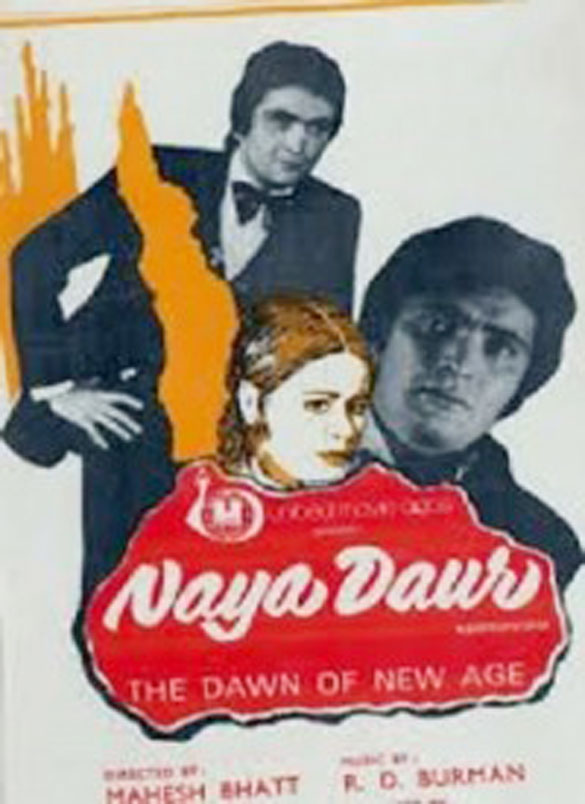Naya Daur Review {4.0/5} & Review Rating
“How one album has such a huge number of chartbuster tracks?” – This is the first thought that comes in mind while looking at the inlay card of Naya Daur! And this is when you also realize why lyricist Sahir, composer O.P. Nayyar and director B.R. Chopra are treated as legends!
With Naya Daur, they made a film which is relevant even today while adding songs that are still loved and known by all. If in 50s, Naya Daur dealt with a battle between man and machine, 50 years down the line it is still valid as the debate has reached the next level with comparisons between machines and computers! Nevertheless, one plays on the album to revisit the classics from the era that has gone by.
We just heard Pritam incorporating the ‘mukhda’ of ‘Uden Jab Jab Zulfen Teri‘ in Alisha Chinoy rendered ‘It’s Rocking‘ for Kya Love Story Hai. Now revisit the classic track in it’s original form with Mohd. Rafi and Asha Bhonsle coming up with an unmatchable camaraderie to create a classic. This is what you actually term as a ‘feel-good’ song. Rhythm, melody, pace, arrangements – just everything works in perfect harmony as O.P.Nayyar creates a tune which would be remembered for 50 more years to come.
Same would hold good for ever-so-naughty ‘Reshmi Salwar Kurta Jali Ka‘ which still continues to be a favorite. One can sense a kind of continuity from ‘Uden Jab Jab…’ to ‘Reshmi Salwar…’ when one observes the orchestra of the two tracks closely. There is a certain similarity to the earthy manner in which the songs have been composed which results in a consistent flow for the album. While Asha Bhonsle makes us believe once again that she has truly been active for more than half a decade, it is nostalgia time to hear Shamshad Begum.
Now this is a kind of tune that has been replicated/duplicated/attempted by many a composers over the decades though with hardly the similar results! Composed for a situation where the lead pair of the film are professing their love for each other atop a horse cart, ‘Maang Ke Saath Tumhara‘ is an utterly romantic number which will stay on to be a landmark song of the century gone by. Mohd. Rafi and Asha Bhosle sealed their association as a duet pair with this song which has a deadly combination of rhythm and melody to make it one of it’s kinds.
‘Dil Leke Daga Denge‘ lasts merely 100 seconds which makes you wonder why the song wasn’t composed as a full blown 4-5 minutes duration conventional track? For the first time in the album there comes a song which doesn’t follow a happy mood and makes you feel sad along with the protagonist. Mohd. Rafi’s voice makes one miss the legend once again and shows once again that how imitators have hardly managed to create a similar feel in spite of repeated attempts.
It’s time to get into a patriotic mode as the ever-so-popular ‘Ye Desh Hai Veer Jawanon Ka‘ makes an entry. An extended one and a half minute ‘dhol’ piece at the very start restates the point that it is not just Yash Raj Films which has used this musical instrument so very effectively in the music of their films. From this point on Mohd. Rafi takes over as he sings a track which is a MUST requirement for each and every wedding celebration up North India. Even though the song is about appreciation of India and Indians, there is something about it which makes people jump on the streets and dance to it regardless of the purpose of celebration.
Call it the beauty of work done by O.P. Nayyar and Sahir that in the very opening lyrics of the song it is made clear that ‘Main Bambai Ka Babu‘ is a ‘Hindustani song rendered in a Western style’! While one relishes the peppy tune, what turns out to be most remarkable is Mohd. Rafi’s rendition as he gets into a completely different mood when compared to each of the other songs he has rendered so far. Sheer versatility – that’s all one can exclaim for the legend.
A social number, ‘Saathi Haath Badhana‘, comes next. With the spirit of togetherness embedded in the song, ‘Saathi Haath Badhana‘ reminds of ‘Chale Chalo‘ from Lagaan which was based on a similar theme. Since the song doesn’t belong to the romantic genre, Mohd. Rafi, Asha Bhonsle along with the chorus singers too modulate their voices accordingly to go with the theme of the song. The proceedings are much more sober and serious this time around even though O.P. Nayyar’s touch is prevalent throughout the track’s duration.
The album ends with Rafi’s solo ‘Aana Hai To Aa‘. A devotional track about waiting for the almighty to get things in order over the period of time, it has a strong classical base to it and deviates from the mostly feel good approach that the songs preceding it had taken. Instead the song takes the listener into a pensive mood as one looks forward to revisiting the situation in the film for which the song must have been composed.
It would be irrelevant to call this piece as a review. With the songs being played on for five decades with generations before us appreciating it for it’s quality, it would be sacrilege to even try finding gaps in the compositions or analyzing it as a pseudo critic. Instead, what makes sense is to simply enjoy the beauty of the tracks and talk about the overall ‘experience’!
Rating: Classic!
#Naya #Daur #Music #Review #Bollywood #Hungama

